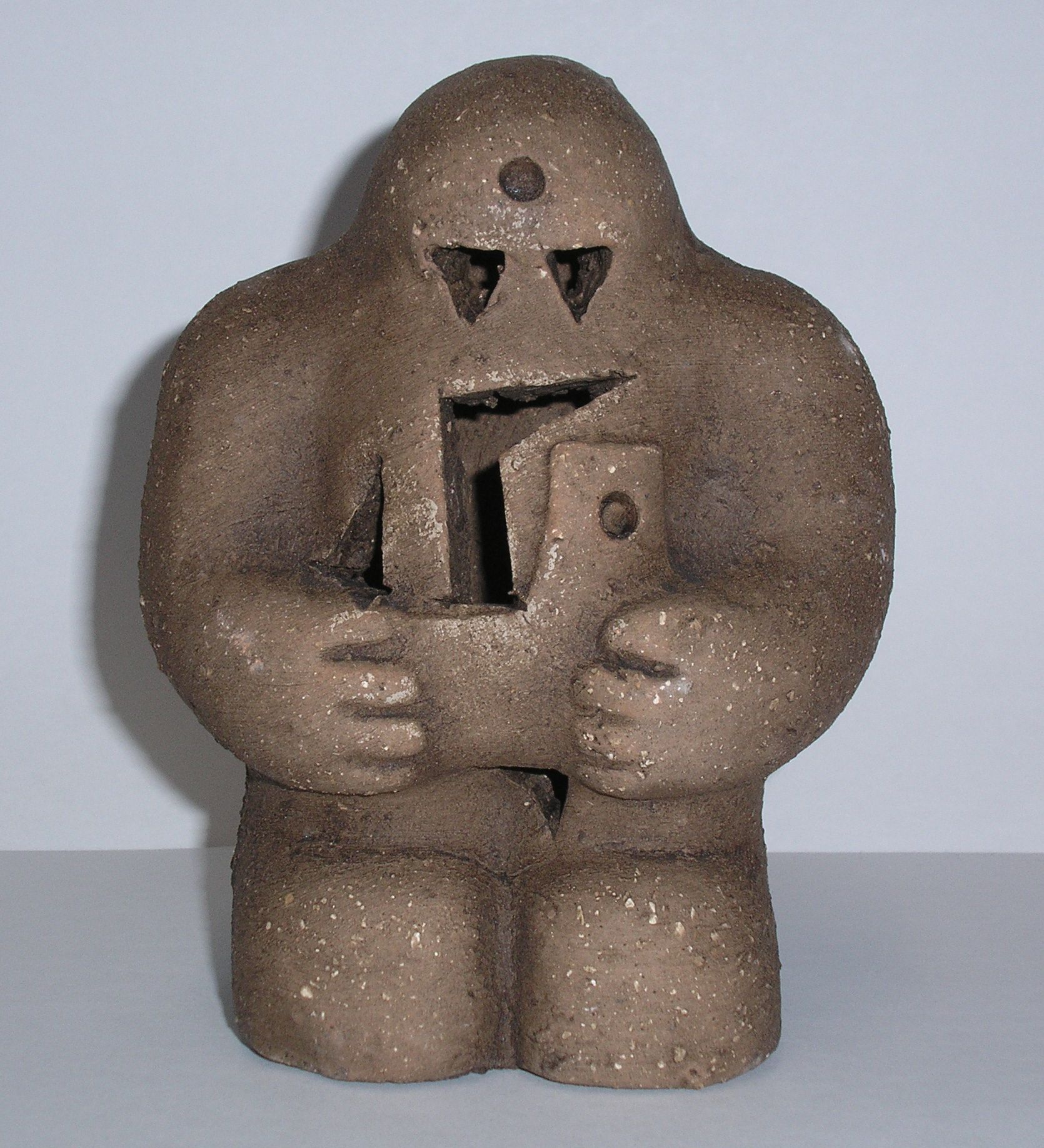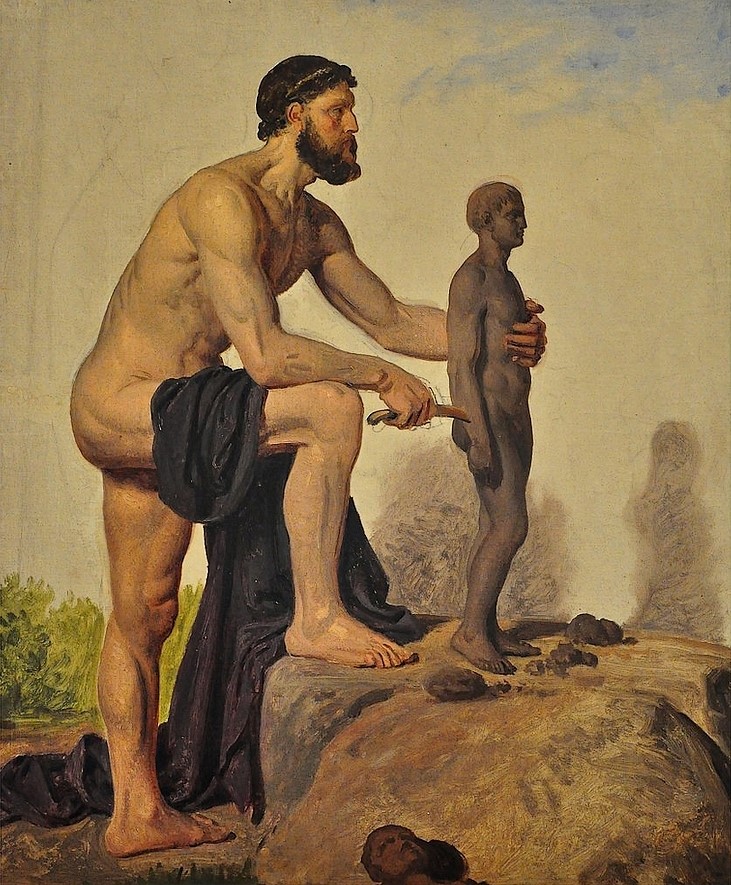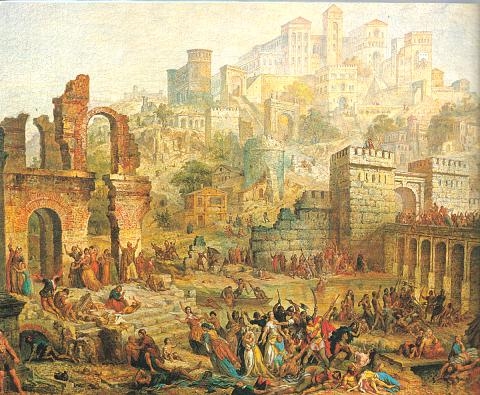|
Golem
A golem ( ; he, , gōlem) is an animated, Anthropomorphism, anthropomorphic being in Jewish folklore, which is entirely created from inanimate matter (usually clay or mud). The most famous golem narrative involves Judah Loew ben Bezalel, the late 16th-century rabbi of Prague. According to ''Moment (magazine), Moment'' magazine, "the golem is a highly mutable metaphor with seemingly limitless symbolism. It can be a victim or villain, Jew or non-Jew, man or woman—or sometimes both. Over the centuries, it has been used to connote war, community, isolation, hope, and despair."Cooper, MarilynJewish Word , Golem" ''Moment (magazine), Moment''. 17 July 2017. 24 August 2017. Etymology The word ''golem'' occurs Hapax legomenon, once in the Bible in Psalm 139:16, which uses the word (; my golem), that means "my light form", "raw" material, connoting the unfinished human being before God's eyes. The Mishnah uses the term for an uncultivated person: "Seven characteristics are in an un ... [...More Info...] [...Related Items...] OR: [Wikipedia] [Google] [Baidu] |
Judah Loew Ben Bezalel
Judah Loew ben Bezalel (; between 1512 and 1526 – 17 September 1609), also known as Rabbi Loew ( Löw, Loewe, Löwe or Levai), the Maharal of Prague (), or simply the Maharal (the Hebrew acronym of "''Moreinu ha-Rav Loew''", 'Our Teacher, Rabbi Loew'), was an important Talmudic scholar, Jewish mystic, and philosopher who, for most of his life, served as a leading rabbi in the cities of Mikulov in Moravia and Prague in Bohemia. Within the world of Torah and Talmudic scholarship, Loew is known for his works on Jewish philosophy and Jewish mysticism and his work ''Gur Aryeh al HaTorah'', a supercommentary on Rashi's Torah commentary. He is also the subject of a 19th-century legend that he created the Golem of Prague, an animate being fashioned from clay. Early life Loew was probably born in Poznań, Poland,—though Perels lists the birth town mistakenly as Worms in the Holy Roman Empire—to Rabbi Bezalel (Loew), whose family originated from the Rhenish town of Worms. Perels c ... [...More Info...] [...Related Items...] OR: [Wikipedia] [Google] [Baidu] |
Creation Of Life From Clay
The creation of life from clay is a miraculous birth theme that appears throughout world religions and mythologies. Religion and folklore * According to Genesis 2:7 "And the Lord God formed man of the dust of the ground, and breathed into his nostrils the breath of life; and man became a living soul". * According to Islamic mythology ( Qur'an 23:12), God created man from clay. * In Jewish folklore, a golem (Hebrew: גולם) is an animated anthropomorphic being that is created entirely from inanimate matter, usually clay or mud. * In Sumerian mythology, the gods Enki or Enlil create a servant of the gods, humankind, out of clay and blood (see Enki and the Making of Man). In another Sumerian story, both Enki and Ninmah create humans from the clay of the Abzu, the fresh water of the underground. They take turns in creating and decreeing the fate of the humans. * According to Egyptian mythology, the god, Khnum, creates human children from clay before placing them into their moth ... [...More Info...] [...Related Items...] OR: [Wikipedia] [Google] [Baidu] |
Jewish Folklore
Jewish folklore are legends, music, oral history, proverbs, jokes, popular beliefs, fairy tales, stories, tall tales, and customs that are the traditions of Judaism. Folktales are characterized by the presence of unusual personages, by the sudden transformation of men into beasts and vice versa, or by other unnatural incidents. A number of aggadic stories bear folktale characteristics, especially those relating to Og, King of Bashan, which have the same exaggerations as have the ''lügenmärchen'' of modern German folktales. Middle Ages There is considerable evidence of Jewish people bringing and helping the spread of Eastern folktales in Europe. Joseph Jacobs.Folk-Tales entry. In: ''The Jewish Encyclopedia''. Vol. 5. New York and London: Funk & Wagnalls company, 1902. pp. 427-428. Besides these tales from foreign sources, Jews either collected or composed others which were told throughout the European ghettos, and were collected in Yiddish in the "Maasebücher". Numbers of t ... [...More Info...] [...Related Items...] OR: [Wikipedia] [Google] [Baidu] |
Aleph
Aleph (or alef or alif, transliterated ʾ) is the first letter of the Semitic abjads, including Phoenician , Hebrew , Aramaic , Syriac , Arabic ʾ and North Arabian 𐪑. It also appears as South Arabian 𐩱 and Ge'ez . These letters are believed to have derived from an Egyptian hieroglyph depicting an ox's head to describe the initial sound of ''*ʾalp'', the West Semitic word for ox (compare Biblical Hebrew ''ʾelef'', "ox"). The Phoenician variant gave rise to the Greek alpha (), being re-interpreted to express not the glottal consonant but the accompanying vowel, and hence the Latin A and Cyrillic А. Phonetically, ''aleph'' originally represented the onset of a vowel at the glottis. In Semitic languages, this functions as a prosthetic weak consonant, allowing roots with only two true consonants to be conjugated in the manner of a standard three consonant Semitic root. In most Hebrew dialects as well as Syriac, the ''aleph'' is an absence of a true co ... [...More Info...] [...Related Items...] OR: [Wikipedia] [Google] [Baidu] |
Shemhamphorasch
''Shem HaMephorash'' ( he, שֵׁם הַמְּפֹרָשׁ ''Šēm hamMəfōrāš'', also ''Shem ha-Mephorash''), meaning "the explicit name," is originally a Tannaitic term describing the Tetragrammaton. In Kabbalah, it may refer to a name of God composed of either 4, 12, 22, 42, or 72 letters (or triads of letters), the latter version being the most common. 12-, 22-, and 42-letter names Early sources, from the Mishnah to Maimonides, only use "Shem ha-Mephorash" to refer to the four letter Tetragrammaton. b. Qiddushin 72a describes a 12-letter name (apparently a mundane euphemism, YHWH-EHYH-ADNY or YHWH-YHWH-YHWH) and a 42-letter name (holy but unknown; Hayy Gaon says it is the acronym of the medieval piyyut Ana b'Koachתשובה אל יוסף בן ברכיה ותלמידי יעקב בן נסים בעניין שמות והשבעות, קונטרס "הדר עם הנכרי בחצר"). A 22-letter name appears in '' Sefer Raziel HaMalakh'', without interpretation, as ('). I ... [...More Info...] [...Related Items...] OR: [Wikipedia] [Google] [Baidu] |
Sefer Yetzirah
''Sefer Yetzirah'' ( ''Sēp̄er Yəṣīrā'', ''Book of Formation'', or ''Book of Creation'') is the title of a book on Jewish mysticism, although some early commentators treated it as a treatise on mathematical and linguistic theory as opposed to Kabbalah. ''Yetzirah'' is more literally translated as "Formation"; the word ''Briah'' is used for "Creation". The book is traditionally ascribed to the patriarch Abraham, although others attribute its writing to Rabbi Akiva. Modern scholars have not reached consensus on the question of its origins. According to Rabbi Saadia Gaon, the objective of the book's author was to convey in writing how the things of our universe came into existence. Conversely, Judah Halevi asserts that the main objective of the book, with its various examples, is to give to man the means by which he is able to understand the unity and omnipotence of God, which are multiform on one side and, yet, uniform on the other. The famous opening words of the book are as ... [...More Info...] [...Related Items...] OR: [Wikipedia] [Google] [Baidu] |
Rava (amora)
Abba ben Joseph bar Ḥama (c. 280 – 352 CE), who is exclusively referred to in the Talmud by the name Rava (), was a Babylonian rabbi who belonged to the fourth generation of amoraim. He is known for his debates with Abaye, and is one of the most often cited rabbis in the Talmud. Biography He was born about 280 CE in Mahoza (a suburb of Ctesiphon, the capital of Persia), where his father was a wealthy and distinguished scholar. In his youth Rava went to Sura, where he attended the lectures of Rav Chisda and associated with Rami bar Hama. About ten years after Rami's death Rava married his widow, the daughter of Rav Chisda. It is said that earlier Rav Chisda's daughter sat in her father's classroom, while his students, Rava and Rami bar Hama, stand before them. When Rav Chisda asked her which of the two she wants to marry, she replied "both of them," and Rava added, "I'll be the last one" (commentators let us know that she indeed married Rami first and Rava second). They had fi ... [...More Info...] [...Related Items...] OR: [Wikipedia] [Google] [Baidu] |
Eleazar Ben Judah
Eleazar of Worms (אלעזר מוורמייזא - also מגרמייזא of Garmiza or Garmisa) (c. 1176–1238), or Eleazar ben Judah ben Kalonymus, also sometimes known today as Eleazar Rokeach ("Eleazar the Perfumer" אלעזר רקח) from the title of his ''Book of the Perfumer'' (''Sefer ha rokeah'' ספר הרקח)—where the numerical value of "Perfumer" (in Hebrew) is equal to Eleazar, was a leading Talmudist and Kabbalist, and the last major member of the '' Hasidei Ashkenaz'', a group of German Jewish pietists. Biography Eleazar was most likely born in Mainz. Through his father Judah ben Kalonymus, he was a descendant of the great Kalonymus family of Mainz. Eleazar was also a disciple of Judah ben Samuel of Regensburg (Judah he-Hasid), who initiated him into the study of the Kabbalah, at that time little known in Germany. According to Zunz, Eleazar was hazzan at Erfurt before he became rabbi at Worms. In 1233 he took part in the Synod of Mainz which enacted the ... [...More Info...] [...Related Items...] OR: [Wikipedia] [Google] [Baidu] |
Brothers Grimm
The Brothers Grimm ( or ), Jacob (1785–1863) and Wilhelm (1786–1859), were a brother duo of German academics, philologists, cultural researchers, lexicographers, and authors who together collected and published folklore. They are among the best-known storytellers of folk tales, popularizing stories such as "Cinderella" ("), "The Frog Prince" (""), "Hansel and Gretel" ("), " Little Red Riding Hood" (""), "Rapunzel", "Rumpelstiltskin" (""), "Sleeping Beauty" (""), and "Snow White" (""). Their first collection of folk tales, ''Children's and Household Tales'' (), began publication in 1812. The Brothers Grimm spent their formative years in the town of Hanau in the Landgraviate of Hesse-Kassel. Their father's death in 1796 (when Jacob was eleven and Wilhelm was ten) caused great poverty for the family and affected the brothers many years after. Both brothers attended the University of Marburg, where they developed a curiosity about German folklore, which grew into a lifelong ... [...More Info...] [...Related Items...] OR: [Wikipedia] [Google] [Baidu] |
Names Of God In Judaism
Judaism considers some names of God so holy that, once written, they should not be erased: YHWH, Adonai, El ("God"), Elohim ("God," a plural noun), Shaddai ("Almighty"), and Tzevaot (" fHosts"); some also include Ehyeh ("I Will Be").This is the formulation of Joseph Karo (SA YD 276:9). Maimonides (MT Yesodei haTorah 6:2), Jacob b. Asher (AT YD 276), and Isaac Alfasi (HK Menachot 3b) also included Ehyeh, as do many later authorities, including Moses Isserles (SA YD 276:9). The original lists are found in y. Megillah 1:9 and b. Shavuot 35a, with some MSS agreeing with each authority. Maimonides and followers give the number of names as seven; however, manuscript inconsistency makes it difficult to judge which are included. Early authorities considered other Hebrew names mere epithets or descriptions of God and wrote that they and names in other languages may be written and erased freely. However, some moderns advise special care even in these cases, and many Orthodox Jews have ad ... [...More Info...] [...Related Items...] OR: [Wikipedia] [Google] [Baidu] |
Hebrew Alphabet
The Hebrew alphabet ( he, אָלֶף־בֵּית עִבְרִי, ), known variously by scholars as the Ktav Ashuri, Jewish script, square script and block script, is an abjad script used in the writing of the Hebrew language and other Jewish languages, most notably Yiddish, Ladino, Judeo-Arabic, and Judeo-Persian. It is also used informally in Israel to write Levantine Arabic, especially among Druze. It is an offshoot of the Imperial Aramaic alphabet, which flourished during the Achaemenid Empire and which itself derives from the Phoenician alphabet. Historically, two separate abjad scripts have been used to write Hebrew. The original, old Hebrew script, known as the paleo-Hebrew alphabet, has been largely preserved in a variant form as the Samaritan alphabet. The present "Jewish script" or "square script", on the contrary, is a stylized form of the Aramaic alphabet and was technically known by Jewish sages as Ashurit (lit. "Assyrian script"), since its origins we ... [...More Info...] [...Related Items...] OR: [Wikipedia] [Google] [Baidu] |







